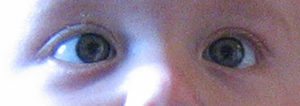
Strabismus is a name given to visual problems in which the eyes are not properly lined up and prevents eyes from working as a team. While one eye looks directly at the object you are looking at, the other eye may be misaligned inward (estropia, also called crossed eyes), outward (exotropia, also called wall-eyed), upward (hypertropia) or downward (hypotropia.)
Strabismus can be constant or sporadic. It may always affect the same eye, called unilateral strabismus, or each eye may take turns being misaligned, which is called alternating strabismus.
Signs and Symptoms
The main sign of strabismus is a misalignment of the eyes that can be easily seen. One eye turns in, out, up, down or at an oblique angle. If the misalignment of the eyes is large and obvious, the strabismus is called “large-angle.” A less obvious eye turn is called a “small-angle” strabismus.
With large-angle strabismus, there are no symptoms such as eye strain and headaches because the brain makes virtually no attempt to straighten the eyes. If the affected eye is left untreated, this type of strabismus will lead to amblyopia also known as lazy eye.
Small-angle strabismus is less noticeable but more likely to cause disruptive visual symptoms such as:
- Headaches
- Eyestrain
- An inability to read comfortably
- Reading fatigue
- Unstable or ‘jittery” vision
Small-angle strabismus that’s constant and unilateral can lead to significant amblyopia in the misaligned eye.
Psychological Effects
Any type of strabismus can be psychologically damaging and affect the self-esteem of both children and adults. That’s because the condition interferes with normal eye contact with others and often causes embarrassment and awkwardness.
Causes of Strabismus
Each eye has six external muscles called extraocular muscles. These muscles control eye position and movement. The position, neurological control and functioning of these muscles in both eyes must be coordinated perfectly for normal vision. When there are neurological or anatomical problems that interfere with the control and function of the extraocular muscles, strabismus occurs. The problem may start in the muscles themselves or in the nerves or vision centers in the brain that control normal vision.
If you or your spouse has strabismus, your children have a greater risk of developing it, as well. Usually, the earlier strabismus is detected and treated, the more successful the outcome, so routine eye exams are recommended for children.
Newborns frequently have intermittent crossed eyes due to incomplete vision development, but this often disappears as the child grows and the visual system matures. However, most types of strabismus don’t disappear as a child grows.
Treatment Options
Without treatment, a child may develop double vision, amblyopia or visual symptoms that could interfere with learning. In many cases, the only effective solution for a consistent eye turn is surgery. The earlier strabismus is treated surgically, the more successful it will be. In some cases, more than one surgery may be needed.
In the case of intermittent or small-angle strabismus, it may be possible to improve eye alignment with vision therapy. A strabismus surgeon may sometimes recommend a program of vision therapy for a period of time after surgery to treat amblyopia and minor binocular vision problems that may remain after surgery.

